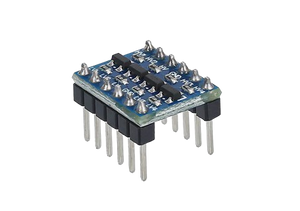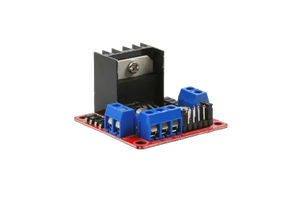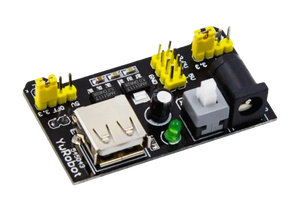
What is the MPU6050?
The MPU6050 is a versatile and widely-used sensor that combines a 3-axis gyroscope and a 3-axis accelerometer on a single chip. This powerful combination allows the MPU6050 to measure both rotational and linear motion, making it ideal for a variety of applications, from robotics and gaming to health and fitness tracking. Its ease of use and compatibility with popular microcontrollers like the Raspberry Pi and Arduino have made it a favorite among hobbyists and professionals alike.
Explore More About This Product
Check out these videos and articles to gain deeper insights into how you can make the most of this product:
- How to Use MPU6050 with Raspberry Pi Pico
- How to Connect MPU6050 to Arduino UNO
- How to Calibrate MPU6050
- Complete Guide: How to Connect MPU6050 to ESP32
- How to Connect MPU6050 to Arduino Nano Every
Operating Mechanisms of the MPU6050
The MPU6050 operates by utilizing its integrated 3-axis gyroscope and 3-axis accelerometer to measure motion in six degrees of freedom. Here's a breakdown of its operating mechanisms:
- 3-Axis Gyroscope: The gyroscope measures rotational velocity around the X, Y, and Z axes. It detects changes in orientation and angular motion, which is crucial for applications requiring precise control and stability, such as drone flight stabilization or motion-capture systems.
- 3-Axis Accelerometer: The accelerometer measures linear acceleration along the X, Y, and Z axes. It detects changes in position and movement, providing data on tilt, orientation, and impact forces. This is particularly useful in applications like smartphone motion sensing, fitness tracking, and robotics.
- Digital Motion Processing (DMP): The MPU6050 features an onboard Digital Motion Processor that offloads complex motion processing tasks from the host microcontroller. The DMP can process raw sensor data, apply sensor fusion algorithms, and output stable and accurate motion data.
- Communication Interface: The MPU6050 communicates with microcontrollers via the I2C protocol, making it easy to integrate with devices like the Raspberry Pi and Arduino. The sensor's registers can be accessed and configured through simple I2C commands, allowing for customizable data acquisition and control.
- Interrupts: The MPU6050 includes programmable interrupt features, enabling it to trigger actions based on specific motion events. For example, it can generate an interrupt when a specific threshold of acceleration or rotation is exceeded, which is useful for applications requiring real-time response to motion.
By combining these mechanisms, the MPU6050 provides a comprehensive solution for motion sensing and control, making it an essential component in many modern electronic projects.
Pins

MPU-6050 Pinout
VCC (Power Supply: +3V to +5V)
This pin is used to supply power to the MPU-6050. The sensor operates within a voltage range of 3V to 5V.
Connection: Connect this pin to the 3.3V or 5V power supply from your microcontroller or development board.
GND (Ground)
This pin is the ground connection for the sensor. It should be connected to the ground of your power supply or microcontroller.
Connection: Connect this pin to the ground (GND) of your microcontroller or development board.
SCL (Serial Clock)
This pin is used for the I2C clock signal. It synchronizes the data transfer between the MPU-6050 and the microcontroller.
Connection: Connect this pin to the I2C clock pin (SCL) on your microcontroller.
SDA (Serial Data)
This pin is used for the I2C data signal. It is used for bidirectional data transfer between the sensor and the microcontroller.
Connection: Connect this pin to the I2C data pin (SDA) on your microcontroller.
XDA (Auxiliary Serial Data)
This pin is used as an auxiliary I2C data line. It can be connected to an external magnetometer or another sensor for additional data acquisition.
Connection: Typically used for interfacing with auxiliary sensors. If not used, leave this pin unconnected.
XCL (Auxiliary Serial Clock)
This pin is used as an auxiliary I2C clock line. It can be connected to an external magnetometer or another sensor.
Connection: Typically used for interfacing with auxiliary sensors. If not used, leave this pin unconnected.
ADO (I2C Address Select)
This pin is used to select the I2C address of the MPU-6050. It allows you to change the address if there is a conflict with other I2C devices.
Connection: Connect this pin to GND to set the I2C address to 0x68. Connect it to VCC to set the address to 0x69.
INT (Interrupt)
This pin is used to output interrupt signals from the MPU-6050 to the microcontroller. It can alert the microcontroller to specific events such as motion detection.
Connection: Connect this pin to an interrupt-capable pin on your microcontroller if you want to use the interrupt feature. Otherwise, you can leave it unconnected.
Technical Specifications
| Specification | Details |
|---|---|
| Sensor Type | 6-axis accelerometer and gyroscope |
| Accelerometer Range | ±2g, ±4g, ±8g, or ±16g |
| Gyroscope Range | ±250°/s, ±500°/s, ±1000°/s, or ±2000°/s |
| Sensitivity | 16,384 LSB/g (for ±2g range); 131 LSB/°/s (for ±250°/s range) |
| Interface | I2C (up to 400kHz) |
| Power Supply | 3-5V |
| Operating Temperature | -40°C to +85°C |
| Dimensions | 25.5 x 15.2 x 2.48mm (1 x 0.6 x 0.09in) |



